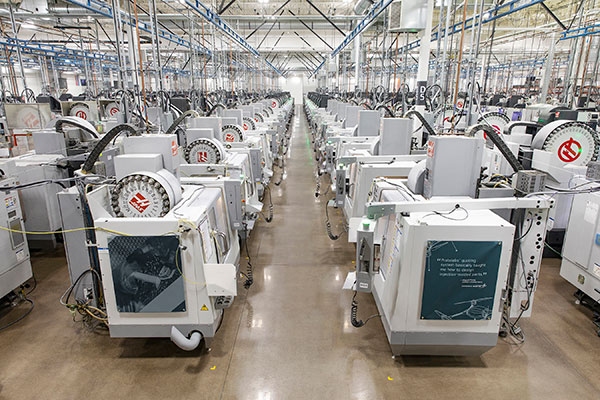Diversification and Domestic Production Keep Rising
On-demand manufacturers brace for supply chain volatility.

Protolabs relies on its in-house production facilities to be able to respond to customers’ requests. Image courtesy of Protolabs.
Latest News
February 21, 2023
Diversify—this word has long served as standard investment advice. It may also become the new supply chain mantra for manufacturers. Recently, the pandemic, the war in Europe and the political tension between the U.S. and China taught us to expect the unexpected, to anticipate tectonic shifts and anomalies as part of the foreseeable future. This feature examines the role of on-demand manufacturing service providers in coping with the emerging volatility.
Concerns Persist
A significant 90% of CEOs expect supply chain concerns to stretch well into 2023, according to a 2022 poll jointly conducted by Xometry and Forbes. But that figure reveals resilience in the face of continued disruption, according to the companies conducting the poll. The survey also found nearly two-thirds (64%) of the CEOs are “currently reshoring or nearshoring their operations or planning to.” (“Building American Manufacturing Resilience,” September 2022).
About 500,000 suppliers are in the combined network of Xometry Marketplace and Thomasnet.com, owned by Xometry, according to Xometry. Bill Cronin, Xometry chief revenue officer, clarified that Xometry is a global marketplace and Thomasnet.com has mostly North American suppliers.
“Because of the various macro-economic and global events of the last few years, we are seeing companies create redundant operations and create locally resilient supply chains to ensure that they can continue bringing their goods to market,” Cronin says.
Putting Boots on the Ground
Every year, on-demand manufacturing service provider Fictiv publishes a State of Manufacturing Report, detailing notable trends.
According to its 2022 report, “The uncertainty surrounding overseas logistics continues to be a concern for companies. That’s why 65% of companies plan to increase U.S. manufacturing this year—and that’s especially true for larger companies, where almost three-quarters of the respondents are prioritizing domestic production.”
From 2019 to 2021, COVID-19 was the culprit. But in February 2022, a new threat emerged: Russia’s invasion of Ukraine. The growing political tension between the U.S. and China also adds anxiety. In peacetime, supply chain activities are generally stable. But in times of crisis, they become wildly unpredictable. Manufacturing closer to home or closer to the point of sale is one way to minimize the risk associated with volatility.
“In 2020, when the pandemic was at its peak in Asia, we had 249 orders placed in the Pearl River Delta Region [Guangdong, Hong Kong, Macau]. So we deployed our disaster recovery plan, which was to redistribute these orders to our partners in the unaffected areas. We didn’t miss a beat,” says Dave Evans, co-founder and CEO of Fictiv.
This, Evans points out, is the same model used in high-performance computing setups like Amazon Web Services. If some servers go down due to a regional disaster, the workload is redistributed to servers located elsewhere. That requires a nimble, responsive network. Fictiv’s global manufacturing network is made up of about 250 partners in various geographies: roughly 60% is in the U.S., 30% in China and 10% in India.
“We believe in keeping it to a smaller, highly vetted network, as opposed to a larger, less vetted marketplace, growing it to thousands of partners,” says Evans. Fictiv uses a web-based user interface to let customers easily submit a part, then receive quotes for the job. The deceptively simple setup makes some believe Fictiv is simply matchmaking the requests to the available shops in the network. In reality, the company’s staff is a lot closer to the action.
“We have boots on the ground, meaning staff in the regions where we manufacture. That makes a difference,” says Evans.

In its partner recruitment, Fictiv didn’t intentionally avoid Europe for any reason, but now that the region is embroiled in conflict, the company will not be expanding there, Evans says. “Our customers didn’t push us to go to Europe,” he explains. “Mainly, they are looking for low-cost offshoring to Asia. Lately, reshoring to the U.S. is becoming important.”
China Still a Dominant Force
Though the U.S.-China relationship is currently strained, Evans doesn’t foresee U.S. manufacturers abandoning it.
“Our customers see a need to operate in China,” says Evans, who notes the region is strategically important for many of its top customers because of its strong infrastructure for manufacturing. “So it might get harder to operate there. It might be harder to travel there, but I don’t think we’ll see people pulling away from it,” he adds. “But we also see other regions becoming more competitive,” such as India.
The pandemic wreaked havoc in the supply chain, but it didn’t reduce demand, Evans says. Therefore, the pressure is on the manufacturers to do more with less resources.
“So even with recession worries, we expect people to outsource and rely on on-demand networks like ours,” he says. “We should stop looking at these disruptions as unique events. Instead, we should start thinking about building truly agile supply chains.”
Fictiv Essentials, which enables users to create an account and get quotes, is free. Last October, Fictiv introduced Fictiv Premium, a paid annual membership program. The new offering comes with team workspaces, multi-team controls, lead-time optimizer and preferred pricing, among other benefits.
“The process for teams ordering custom mechanical parts has historically been very inefficient, time intensive and filled with blind spots for engineers and supply chain professionals,” says Evans. “With Fictiv Premium, we are expanding our service to provide customers with the tools they need to gain critical visibility, control and speed in new product development and beyond.”
With added level of transparency, Evans points out it’s easier to compare the different sourcing choices and simulate various scenarios. “You could compare, for example, the price and lead time for ordering a part from China as opposed to making it locally in the U.S. If you need your order delivered on May 4, you can figure out what variables you need to change to make it happen,” says Evans.
Domestic Manufacturing Muscles
Founded in 1999 as a quick-turn manufacturer of injection-molded parts, Protolabs expanded to become an on-demand manufacturer offering a range of options, including 3D printing and computer-numerically controlled (CNC) machining. This domestic in-house production muscle is the strength of Protolabs, according to Gurvinder Singh, the company’s global product and strategy director.
Protolabs has manufacturing partners in the U.S., Europe, India, China and Mexico, Singh says. In early 2021, Protolabs acquired Hubs, an online manufacturing platform. The move added roughly 240 global manufacturing partners to the company’s network. When Asian manufacturing activities shut down during the pandemic, the company also added some partners in India as a balancing act. But the lion’s share of Protolabs’ orders are filled by its in-house facilities, according to Singh.
The experiences from the COVID shutdown and the war in Europe taught manufacturers that, the longer the products must travel, the greater the risk of disruption.
“As a result, we saw more customers rethinking their supply chain strategies. They began balancing their regions. The preference now is to keep production closer to the region of consumption. Some call it relocalization,” Singh says.
According to the Reshoring Initiative 2021 Data Report, “For the second year in a row, reshoring exceeded FDI [foreign direct investment] by 100%, continuing a recent trend not seen since 2013. Additionally, the number of companies reporting new reshoring and FDI set a new record of over 1,800 companies.”
Singh says he also saw the rise of dual sourcing as a safety measure. “Instead of sourcing from a single supplier, some sourced from two different vendors. One could be local to address the urgent demands,” he says.
Protolabs’ responsiveness comes from its strategy to always maintain open capacity, according to Singh. “We don’t like to be running at 100% utilization. In 2020 and 2021, when we reached full capacity, we went ahead and bought more facilities and doubled our capacity to keep extra room,” he says.
The company also began adopting more automation. To continue operating during the COVID shutdown, Protolabs acquired 25 cobots (collaborative robots). They are now part of the company’s operations in its Rosemount, MN, facility. “Before COVID, we had just one cobot, but it was in our roadmap to use more. This shows an acceleration of the fourth industrial revolution—more digitization and automation,” he says.
More Fictiv Coverage
More Protolabs Coverage
Subscribe to our FREE magazine, FREE email newsletters or both!
Latest News
About the Author
Kenneth Wong is Digital Engineering’s resident blogger and senior editor. Email him at kennethwong@digitaleng.news or share your thoughts on this article at digitaleng.news/facebook.
Follow DE





